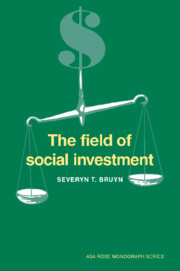Book contents
- Frontmatter
- Contents
- Preface
- Part I The idea of social investment
- Part II Social criteria and research
- 4 Social investment in business corporations
- 5 Social investment in industry: a new social policy
- 6 Social research on industrial policy
- 7 Investment in community development
- Part III Global social investment
- Epilogue: Social investment as a self-correcting movement in the market system
- Notes
- Bibliography
- Name index
- Subject index
- Title in the Series
7 - Investment in community development
Published online by Cambridge University Press: 19 January 2010
- Frontmatter
- Contents
- Preface
- Part I The idea of social investment
- Part II Social criteria and research
- 4 Social investment in business corporations
- 5 Social investment in industry: a new social policy
- 6 Social research on industrial policy
- 7 Investment in community development
- Part III Global social investment
- Epilogue: Social investment as a self-correcting movement in the market system
- Notes
- Bibliography
- Name index
- Subject index
- Title in the Series
Summary
Scholars have said that the local community in the United States is perilously close to extinction. Many studies describe its “decline” and even its “eclipse.” Some observers interpret the phenomenon as an inevitable and irreversible part of modern development. The idea that a residential group could develop a fair degree of economic self-determination is perceived as a fiction in contemporary society.
The loss of economic self-determination at the local level is mirrored now by the disappearance of community studies in the professions. The local community was a major focus of sociological research in the first half of this century but today it has lost its appeal. Because it has declined in its power of self-direction, it no longer has the same significance. Similarly, community planning was a major interest of city planners an architects, but the concept is no longer discussed in their journals. The idea of constructing autonomous communities is regarded by many planners today as hopelessly Utopian. The notion of community development thus has little appeal for those in a position to encourage it in postindustrial society.
The concept of developing self-reliant communities was first questioned by city planners facing urban sprawl but now it is wholly eclipsed from the work of planners looking at the megalopolis. The megalopolis is a vast stretch comprising metropolises developing without plan in a particular region. The Eastern seaboard is one example, described by Jean Gottman as a metropolitan agglomeration reaching from southern New Hampshire to northern Virginia.
- Type
- Chapter
- Information
- The Field of Social Investment , pp. 147 - 184Publisher: Cambridge University PressPrint publication year: 1987



